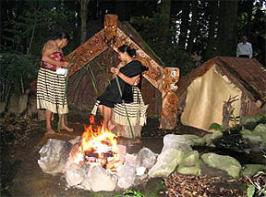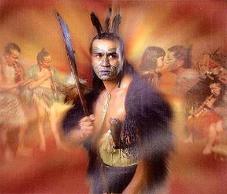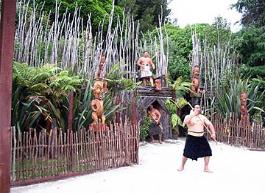
New Zealand Travelogue
Nature at its Best
Nature at its Best





Part 3
By Susie R. Cuñada
“Buried Village”
As a backgrounder, Mount Tarawera plays an important role in the history of New
Zealand and the Rotorua region. It is sacred and under the guardianship of a
Maori tribe. In the 1800s, the Tarawera region was the centre of tourism in New
Zealand. People traveled from all over the world to view the famous Pink and
White Terraces, which were quickly becoming known as the 'Eighth Wonder of the
World.' The terraces were destroyed on June 10, 1886, in an eruption which killed
more than 150 people and devastated the surrounding landscape. Violent
explosions excavated huge craters, one of which is now filled by picturesque Lake
Rotomahana.
Today, the “Buried Village” is an excavated village of Te Wairoa which offered first-
hand insight into the devastation, chaos and mayhem that transpired on the night
the Tarawera volcano erupted. In the village, I took an emotional journey through
the museum which related the fascinating story of Te Wairoa village, the voyages
to the Pink and White Terraces and the eruption of Mount Tarawera; and inspected
the registered historic area where Maori whare (houses) and settler buildings
have been excavated to their original floor level. I also saw some artifacts and
belongings recovered from the village. Then I wandered through the scenic
pathways that linked the excavated sites, enjoyed unspoilt native bush and the Te
Wairoa stream full of rainbow trout; and was thrilled by the hike to stand in the
spray of the magnificent Te Wairoa falls which plunge 30 meters to the bush-clad
valley below. It was very historical and interesting for me because I was
transported back in time and history became alive before my very eyes.
By Susie R. Cuñada
“Buried Village”
As a backgrounder, Mount Tarawera plays an important role in the history of New
Zealand and the Rotorua region. It is sacred and under the guardianship of a
Maori tribe. In the 1800s, the Tarawera region was the centre of tourism in New
Zealand. People traveled from all over the world to view the famous Pink and
White Terraces, which were quickly becoming known as the 'Eighth Wonder of the
World.' The terraces were destroyed on June 10, 1886, in an eruption which killed
more than 150 people and devastated the surrounding landscape. Violent
explosions excavated huge craters, one of which is now filled by picturesque Lake
Rotomahana.
Today, the “Buried Village” is an excavated village of Te Wairoa which offered first-
hand insight into the devastation, chaos and mayhem that transpired on the night
the Tarawera volcano erupted. In the village, I took an emotional journey through
the museum which related the fascinating story of Te Wairoa village, the voyages
to the Pink and White Terraces and the eruption of Mount Tarawera; and inspected
the registered historic area where Maori whare (houses) and settler buildings
have been excavated to their original floor level. I also saw some artifacts and
belongings recovered from the village. Then I wandered through the scenic
pathways that linked the excavated sites, enjoyed unspoilt native bush and the Te
Wairoa stream full of rainbow trout; and was thrilled by the hike to stand in the
spray of the magnificent Te Wairoa falls which plunge 30 meters to the bush-clad
valley below. It was very historical and interesting for me because I was
transported back in time and history became alive before my very eyes.
My Maori Experience
I want to delve exclusively into my Maori experience because it’s an experience of a
lifetime. It is so memorable that I can’t still get over it until now. Vivid memories, I tell you.
My NZ Maori cultural experience began in Rotorua with the Tamaki family. We were
picked up from our accommodation in a Tamaki coach which magically transformed into
a canoe (waka). Part of our job was to begin rowing the waka south of the city centre to
the Tamaki Maori Village which was set in an ancient Tawa forest. En route to the village,
we selected a chief from amongst us and our guide talked us through the protocol
surrounding the welcome ceremony (powhiri). For easy reading, I divided it into parts.
The Challenge
No one enters any tribal ground until a powhiri has been completed. The host tribe sent
three different warriors to challenge us, the guests. They were wielding spear-like
weapons and with every muscle, it seems they were looking for a reason to strike. It was
the role of our chief to signal our peaceful intent by picking up the peace offering that had
been laid at his feet. This part of the ceremony can look quite humorous. Out of respect
for their culture, NO LAUGHING, SMILING OR POKING OF THE TONGUE is allowed. All
visitors must remain behind their respective chiefs throughout the ceremony.
The Cry of Welcome
With this, the warrior signaled the home people and a spine-tingling call cut across the
crowd. It was an invitation for us to enter the village. A welcome dance paved our entry
into the sacred grounds of the home people.
The Tawa Forest
Once the formalities of the welcome were complete and we were accepted by the home
people, we stepped through the fortification and went from one world to another. We were
I want to delve exclusively into my Maori experience because it’s an experience of a
lifetime. It is so memorable that I can’t still get over it until now. Vivid memories, I tell you.
My NZ Maori cultural experience began in Rotorua with the Tamaki family. We were
picked up from our accommodation in a Tamaki coach which magically transformed into
a canoe (waka). Part of our job was to begin rowing the waka south of the city centre to
the Tamaki Maori Village which was set in an ancient Tawa forest. En route to the village,
we selected a chief from amongst us and our guide talked us through the protocol
surrounding the welcome ceremony (powhiri). For easy reading, I divided it into parts.
The Challenge
No one enters any tribal ground until a powhiri has been completed. The host tribe sent
three different warriors to challenge us, the guests. They were wielding spear-like
weapons and with every muscle, it seems they were looking for a reason to strike. It was
the role of our chief to signal our peaceful intent by picking up the peace offering that had
been laid at his feet. This part of the ceremony can look quite humorous. Out of respect
for their culture, NO LAUGHING, SMILING OR POKING OF THE TONGUE is allowed. All
visitors must remain behind their respective chiefs throughout the ceremony.
The Cry of Welcome
With this, the warrior signaled the home people and a spine-tingling call cut across the
crowd. It was an invitation for us to enter the village. A welcome dance paved our entry
into the sacred grounds of the home people.
The Tawa Forest
Once the formalities of the welcome were complete and we were accepted by the home
people, we stepped through the fortification and went from one world to another. We were
spirited back in time to an era before the arrival of the Europeans to capture the essence of a proud people. The entire village came
to life with chants, songs, games, haka (war chant), art and craft. With fires blazing throughout the village, we were able to
experience weapon demonstrations, horticulture and the fine art of moko (tattooing).
The Meeting House
Again, the call cut through the forest. We were called into a meeting house that stood in a clearing at the end of the forest pathway.
The building represents an ancestor of their past. Their customs are: a) women must not be seated in the front row. This is
because if fighting were to occur between the home people and the visitors, the men would be the protectors; b) the men make all
the welcome speeches; c) all visitors must remain seated during the speeches. It was there a speech of welcome was offered by
the people of the land. A song was offered in support of the speech. Then the “hongi” (pressing of the noses which, by the way, is
their form of greeting) is performed by the chiefs and the people of the land. This seals the bond of friendship between the different
cultures. After the speeches, the people of the land shared a variety of haka and history, both ancient and more recent, in celebration
of new friendships forged.
The Dining Room
After the performance, we were invited to the dining room. Everything was far more relaxed, and it was clear we were part of the
bigger family atmosphere. One of our hosts blessed the food with a prayer and the Hangi meal was served.
The traditional Hangi, which has been under the earth on hot rocks for three to four hours, is the age-old traditional cooking method
of the Maori. The rocks are heated to a white hot state with some of their native timber. They are then put into a pit dug in the earth.
The baskets of meat are put directly on the hot stones, then the vegetable baskets and then the pudding basket on top of that. A wet
cloth is placed over the food followed by wet hessian. Earth is then piled quickly over everything to keep the heat inside the earth
oven.
Closing Ceremony and the Journey Home
With the meal concluded and time taken to explore the tribal marketplace, our hosts, as well as a number of the guides, waiting staff,
and anyone who knows the tradition, took the floor once more for the official closing ceremony. Special thanks were offered to those
who have prepared our meal. This happens at all marae where food and hospitality hold such a place in the Maori culture. There
were songs and speeches once again, light-hearted and with a sense of the new friendship we had established throughout the
evening.
What a cultural experience altogether! Their songs and dances are an eye opener. Food was excellent. I’m now a convert to eating
lamb. Where before I refused to eat lamb, now I eat only lamb every time I have the opportunity of ordering one.
to life with chants, songs, games, haka (war chant), art and craft. With fires blazing throughout the village, we were able to
experience weapon demonstrations, horticulture and the fine art of moko (tattooing).
The Meeting House
Again, the call cut through the forest. We were called into a meeting house that stood in a clearing at the end of the forest pathway.
The building represents an ancestor of their past. Their customs are: a) women must not be seated in the front row. This is
because if fighting were to occur between the home people and the visitors, the men would be the protectors; b) the men make all
the welcome speeches; c) all visitors must remain seated during the speeches. It was there a speech of welcome was offered by
the people of the land. A song was offered in support of the speech. Then the “hongi” (pressing of the noses which, by the way, is
their form of greeting) is performed by the chiefs and the people of the land. This seals the bond of friendship between the different
cultures. After the speeches, the people of the land shared a variety of haka and history, both ancient and more recent, in celebration
of new friendships forged.
The Dining Room
After the performance, we were invited to the dining room. Everything was far more relaxed, and it was clear we were part of the
bigger family atmosphere. One of our hosts blessed the food with a prayer and the Hangi meal was served.
The traditional Hangi, which has been under the earth on hot rocks for three to four hours, is the age-old traditional cooking method
of the Maori. The rocks are heated to a white hot state with some of their native timber. They are then put into a pit dug in the earth.
The baskets of meat are put directly on the hot stones, then the vegetable baskets and then the pudding basket on top of that. A wet
cloth is placed over the food followed by wet hessian. Earth is then piled quickly over everything to keep the heat inside the earth
oven.
Closing Ceremony and the Journey Home
With the meal concluded and time taken to explore the tribal marketplace, our hosts, as well as a number of the guides, waiting staff,
and anyone who knows the tradition, took the floor once more for the official closing ceremony. Special thanks were offered to those
who have prepared our meal. This happens at all marae where food and hospitality hold such a place in the Maori culture. There
were songs and speeches once again, light-hearted and with a sense of the new friendship we had established throughout the
evening.
What a cultural experience altogether! Their songs and dances are an eye opener. Food was excellent. I’m now a convert to eating
lamb. Where before I refused to eat lamb, now I eat only lamb every time I have the opportunity of ordering one.
